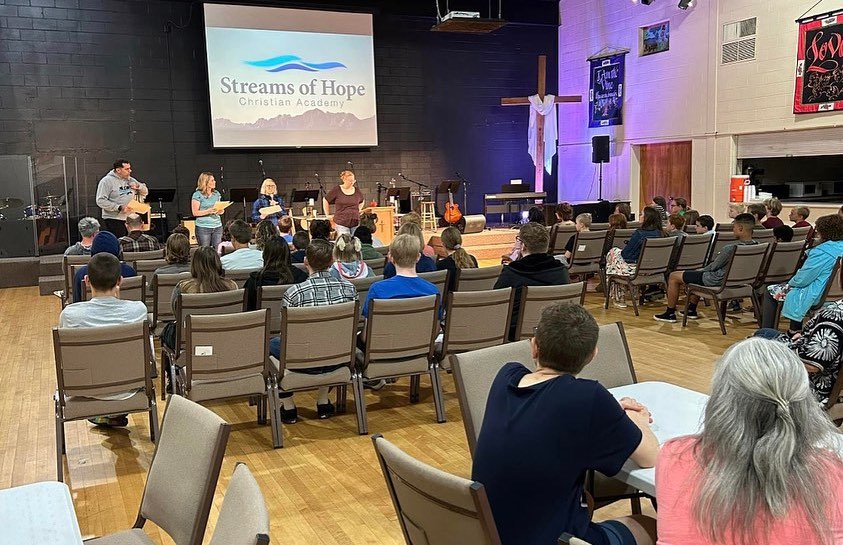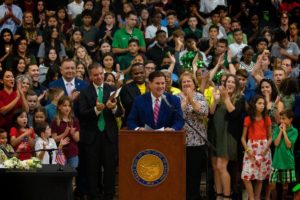Indiana microschool empowers previously failing students, provides ‘homeschooling on steroids’
For Jill Haskins, payday at her job involves the students whose lives changed just by attending Streams of Hope Christian School.
One striking example is a student who transferred at the…

For Jill Haskins, payday at her job involves the students whose lives changed just by attending Streams of Hope Christian School.
One striking example is a student who transferred at the end of 2021 from a public school to the microschool, where Haskins serves as executive director.
“In fourth grade, she was already feeling like she was worthless and unloved,” Haskins said, adding the student was two grade levels behind and suicidal.
In just two years, however, that student now tests 1-2 grade levels ahead in math, science, and literature, Haskins said.
“Her mom can’t talk about their experience here without crying, because she’s like, ‘We have our daughter back,’” she said. “She’s happy, she doesn’t have to be on medication, she’s here. She wants to come to school. She knows she’s loved. … To me that’s payday, students like that.”
‘Christian alternative to public education’
Microschools – small, multifamily learning environments – are growing quickly as an innovative form of education tailored to each student, according to the National Microschooling Center.
These can operate as independent, corporate or partnership-based models according to educational goals, locations and specific community needs.
For example, Streams of Hope functions as a partnership-based ministry of Heartland Church in Fort Wayne, Indiana. Haskins credits Dave Frincke, the church’s senior pastor, with launching the microschool in 2020.
“Our senior pastor really had a desire to offer a Christian alternative to public education,” she said. “He had been dreaming about it for a while.”
Frincke approached Janet Willig, a church member who had taught students at her home-based school called Chicory Academy. Eventually Willig agreed to bring her school over to the church.
“She brought her younger daughter, who was in her 20s,” Haskins said. “They opened up as two classrooms and could take more students than what she had been able to do previously.”
Since the microschool’s launch with about 30 students, enrollment had nearly doubled in the 2022-2023 school year to 55 students.
‘We can look at them as an individual’
The school offers a range of enrollment choices, including half-day and full-day options. Haskins expects further growth from its online classes and homeschool co-op, which both launched this year.
“We have a lot of kids that are coming to us that were failing in public school,” she said. “Their academics were terrible, they were getting Ds and Fs, they were being bullied.”
The microschool’s model attracts families who love its individualized instruction and small class sizes – usually fewer than 20 students, Haskins said.
“They’re not held to a specific pace. They’re not expected to perform like everybody else is. We can look at them as an individual,” she said. “In public school that just doesn’t happen.”
The microschool also accommodates differing family schedules and encourages vacation times together, even during the school year.
“If they want to take a vacation, they’re not going to be turned in to a truant officer for it,” Haskins said. “We’re going to applaud them. … It’s just providing families the flexibility and the hope that they need.”
This flexibility also extends to the microschool’s graduation requirements, which teachers can tailor to each student.
“We can customize their path based on their giftings, strengths, and interests,” said Haskins, recalling one student who came with severe learning disabilities to Streams of Hope from public school.
“He came to us when he was 16, barely reading at a first-grade level,” she said. “He was profoundly dyslexic and had severe trauma in his background, abuse and neglect.”
Rather than trying to cram 15 years’ worth of academic requirements into two years, teachers worked instead to enroll him in a trade school and internships before graduation.
“We’ve seen kids that were straight-F students in public school who here are straight-A students, and they’re thriving,” Haskins said.
Homeschool families also enroll at the microschool, but for other reasons, Haskins said.
“For whatever reason, homeschooling is not working,” she said, adding she had homeschooled her children for more than 6 years before approaching Streams of Hope for help with her youngest son, who has severe dyslexia.
“Maybe a family is going through a financial difficulty and the mom needs to go back and get a job. Or something has happened within the family structure and they just can’t do it anymore.”
‘Homeschooling on steroids’
Once Haskins became involved with the microschool, she helped it develop programs and consulting just for homeschoolers.
“Fort Wayne has a really large homeschooling community, and I love being involved in the homeschool community,” she said. “Some of my best friends and my kids’ best friends are all homeschooled.”
Haskins now describes everything she does at the microschool as “homeschooling on steroids.”
“Everything that we were doing at home, we’re doing here, but on a bigger scale,” she said.
The microschool also provides hybrid options for parents who can’t take on the whole load of homeschooling.
“It would allow families to have some support and structure for their kids, that maybe they want to be involved in their education, but just can’t take on the full responsibility of it,” Haskins said, adding the microschool has a curriculum closet where families can donate used curriculum.
“Families from the community can come and look through and take whatever resources and curriculum that we have here for absolutely free,” she said.
Haskins, now the Indiana Field Coordinator for the National Microschooling Center, is helping build an ecosystem of microschools and learning pods across the state.
“Our ultimate goal is to be a resource, support, connection, and encouragement for others who want to start their own schools,” she said.
It’s also personal for Haskins, who has seen the educational results in her own son, who is now 11.
“He hated anything having to do with learning,” she said. “And last year he couldn’t wait to come to school every day.”
Haskins’ son also enjoys making friends at the school where he can proceed at his own pace regardless of the others around him, he said.
“He doesn’t compare himself to other kids because he doesn’t have to,” she said. “Because none of them are on the same levels in anything. Those are the types of things that are just massively important to us to keep in mind when things are hard.”
This is the first in a series about microschools, which are transforming the landscape of U.S. education. See also:



